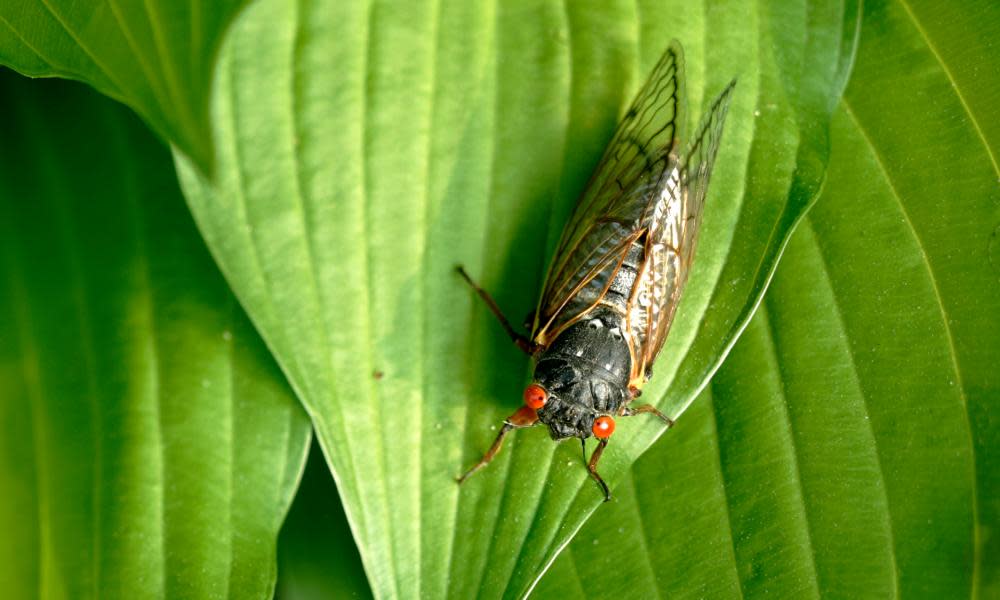US researchers seek citizen scientists as billions of Brood X cicadas set to emerge

As New Yorkers nervously await the emergence of billions of cicada bugs set to swarm through their city and the north-east of the US, researchers are seeking to enlist citizen scientists to track the coming plague.
The so-called Brood X of cicadas are set to emerge after 17 years underground. This particular cohort of the periodic insects will swarm in several large areas in the eastern US, as they prepare for one enormous mate fest, including New York’s Central Park and parts of the Bronx and Staten Island.
Related: ‘A remarkable phenomenon’: billions of cicadas set to emerge across eastern US
Tracking the cicadas is as easy as snapping a photo. Anyone with a smartphone can download the free Cicada Safari app to help with data collection. Once the media is uploaded the app automatically captures the time, date and geographical coordinates. Once the images are verified, the information is mapped.
The app was developed by Gene Kritsky, the dean of Behavioral and Natural Sciences at Mount St Joseph University in Cincinnati and the author of Periodical Cicadas: The Brood X Edition.” The app is available for both iOS and Android operating systems.
The last such Brood X event for 15 states including New York, Ohio, Illinois and Georgia occurred in 2004. They are expected to surface mid-May when temperatures rise.
“They may amass in millions in parks, woods, neighborhoods, and can seemingly be everywhere,” said Gary Parsons, an entomologist at Michigan State University, in January this year. “When they are this abundant, they fly, land and crawl everywhere, including occasionally landing on humans.”
Parsons said that while cicadas will not harm people, pets are at risk of becoming ill should they eat any of these insects. It is thought that long underground development helps cicadas survive predators, as their huge and synchronized arrival provides protection in numbers.
The noise made by the enormous swarms will be noticeable, however, with males emitting mating calls that can reach 100 decibels, the same sound as standing next to a motorcycle revving its engine. The males produce these mating “songs” by vibrating their tymbals, two rigid, drum-like membranes on the underside of the abdomen.
No one knows exactly why the periodic cicadas appear during these synchronized times, but there are several theories to address this evolutionary conundrum.
They live for years underground only to spend a few weeks above it to mate and die. The males sing to attract their mates, almost urgently, and die three to four weeks after the deed is done. The females work to lay as many eggs as possible – up to 600 each – before dying as well.
Kritsky said this year’s emergence could give him and his colleagues a level of detail that has not been seen before in centuries of research about these insects with long life cycles. He expects to receive around 50,000 entries on his app to assist with the research.
“I have been mining historical emergence records for 45 years, and in the process we have discovered new populations of broods that had been missed for over a century,” Kritsky told Entomology Today. “It’s amazing that an insect that has been studied for so long and by so many still has secrets to reveal.”
Despite the large numbers expected in the city, outside of the Big Apple in Long Island, the population of periodic cicadas may be going extinct. In 2004, only a handful of the insects were spotted in central Long Island. The cutting down of trees for new building developments across the island could be the cause. Once the tree is cut, all of the cicadas living underground lose their source of food and die off.
“The cicada broods for the last 200 years have been declining on Long Island in particular,” Dr Michael Raupp, an entomologist at the University of Maryland, told Gothamist. “We’re just keeping [our] fingers crossed that we will see them at least one more time here in 2021.”

